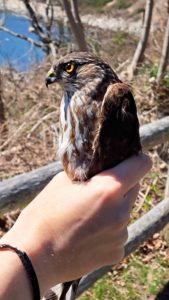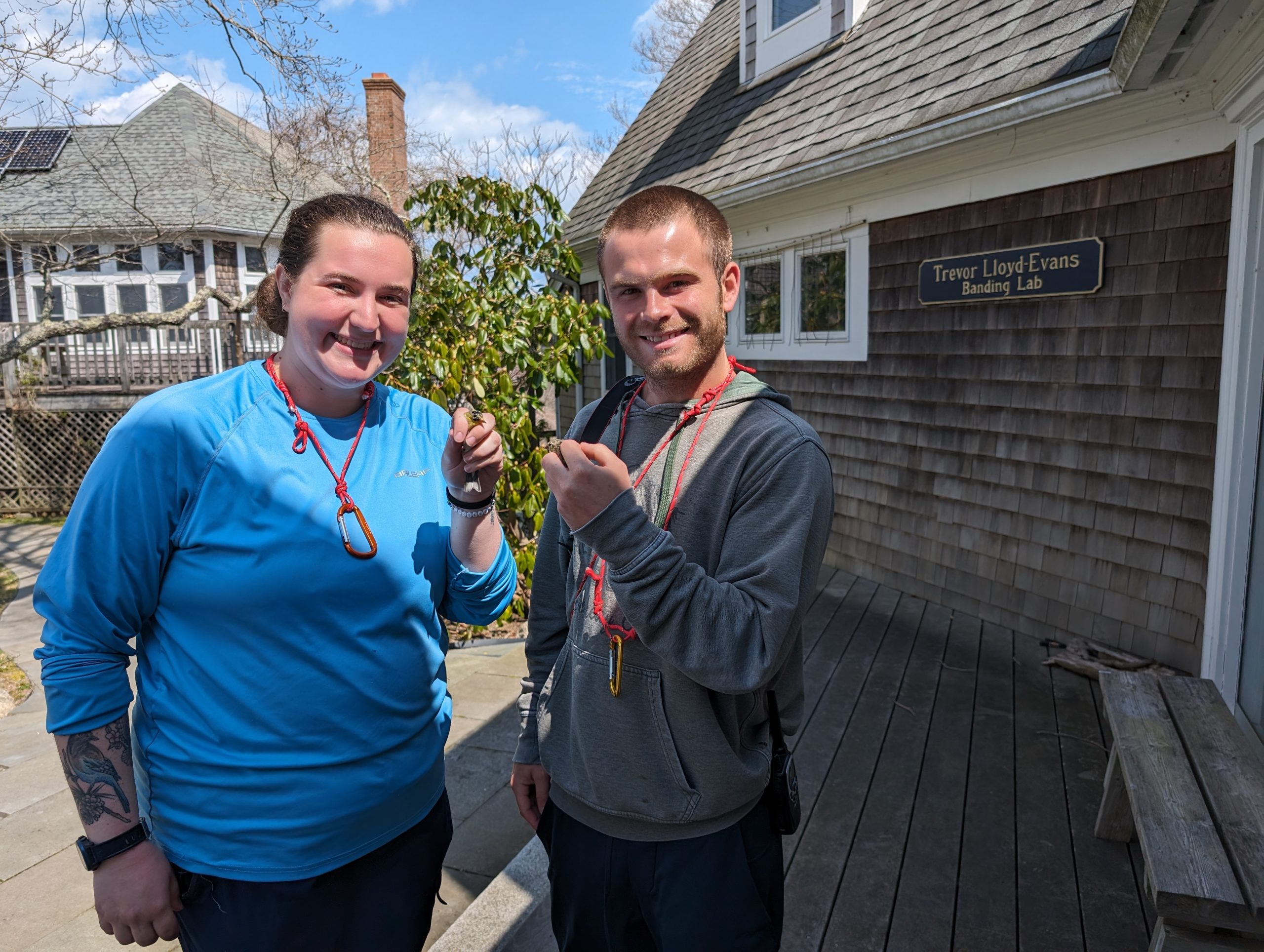Spring is an exciting time at Manomet: not only do many birds return, but so does our seasonal banding team! Every season, Manomet welcomes two bird banders and two bird banding interns to the Trevor Lloyd-Evans Bird Banding Lab at our headquarters – an approximately 40-acre campus on a scenic bluff overlooking Cape Cod Bay. The banders and interns live in the historic Widewater building, and work under the supervision of Manomet Observatory Director, Evan Dalton.
Over the course of a two-month season, Manomet interns learn how to operate mist nets, safely handle and properly band birds, and how to collect and report data on the birds captured. Interns also help Manomet’s Environmental Education and Outreach team teach and inspire students of all ages who come from nearby elementary schools, high schools, and colleges to learn about the art and science of bird banding. Since 1972, Manomet’s banding internship program has helped train over a thousand young professionals in the field of ornithology.

This year, one of our two banding interns is Camille Beckwith, who hails from across the state in Great Barrington, Massachusetts. Her love of birds began when she was a child, surrounded by her nature-loving family. In fact, the study of biology runs in the family: Camille studied biology at Wheaton College, and years earlier her father also studied wildlife biology in college. While at Wheaton, she joined a field trip to Manomet Observatory, which was the first place she saw how wild birds are quickly held, measured, and banded, before they were released back into the world. Aside from a trip to the banding lab, her travels in college included a semester abroad in Tanzania and a field biology course in Ecuador.
Last year, Camille began her career in ornithology as an intern at the Berkshire Bird Observatory in Great Barrington, where she learned how to band birds, rig mist nets, extract, measure and weigh birds to collect data on migratory birds. “The Berkshire Bird Observatory is quite a bit different than here at Manomet – the [study site] is on public land and there aren’t as many nets up,” Camille noted.
Although some of Manomet’s nets overlook the ocean, Camille was surprised to find a very similar assemblage of birds in the nets to the ones in Great Barrington. While shorebirds are plentiful below the bluff, the nets at Manomet rarely catch one. She emphasizes that even though she is working with similar birds, interning at a new banding station is giving her a greater range of experiences. Camille is also honing her skills under the supervision of returning bird banders, Amy Hogan and Sarah Duff, as well as Observatory Director, Evan Dalton.
A Manomet bander’s day starts about 30 minutes before dawn, and is very much weather dependent. Like the rest of us here in the Northeast, Camille is patiently waiting for the warmer temperatures and calm weather to arrive. Emphasizing bird safety, Camille noted: “We don’t put up mist nets or band on rainy or windy mornings.” The recent cold temperatures and windy conditions have meant more time “rolling up the nets” than usual.
When the weather allows, by 5:30am, Camille and Liam are out unfurling the 50 mist nets on the property, and every 30-40 minutes they make their rounds with banders Amy and Sarah. The first order of business is the careful extraction of birds from the net. Each bird is then put into a soft cotton bag, brought to the banding lab, and quickly and gently weighed, measured, and banded. Since all migratory birds in North America are protected by the Migratory Bird Treaty Act, Manomet holds federal and state permits to conduct this research.
Camille is excited to take part in some of the educational programs that take place at Manomet, including the first field trip of the year that arrives this week to the banding lab. She can’t wait to see the faces of awe and excitement of future conservationists. “I really wish I had the opportunity to come here when I was younger. We had field trips, but usually to sanctuaries and wildlife re-habilitation organizations. Manomet is the first place where I saw a wild bird in hand, a bird that was going back to the wild. It was amazing.” Two weeks into her time at Manomet, Camille’s favorite bird to see up close is the Sharp-shinned Hawk. One female and two males were recently caught, and it gave her the opportunity to study the measurable differences between the males and females of the species.
While in Plymouth, Camille has taken in some local culture at the Herring Run Festival (co-sponsored by Manomet recently) and visited the famed Plymouth Rock. In her off time, you might find her in the Manomet kitchen chipping away at an ever-present jigsaw puzzle. And, since you can take the banding intern out of the lab, but not the lab out of the intern: with a few weeks under her belt and warmer days coming, Camille is planning trips to some other local Plymouth wildlife viewing areas.





 Back to all
Back to all